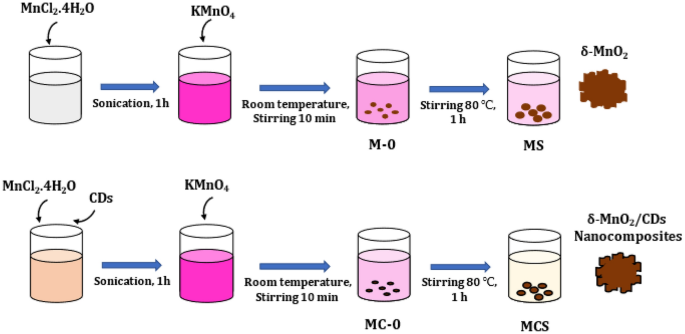Low-temperature synthesis of doped MnO2–carbon dots nanocomposite: an analysis of nanostructure and electrical properties
IF 5.5
Q2 MATERIALS SCIENCE, MULTIDISCIPLINARY
引用次数: 0
Abstract
The synthesis of δ-MnO2, δ-MnO2 carbon dots nanocomposite, and Fe/Cu-doped δ-MnO2 carbon dots nanocomposite has been successfully carried out through a stirring process at room temperature and 80 °C. The synthesized powder shows a low crystallization determined through XRD and TEM analysis. Furthermore, the carbon dots are well attached to MnO2 performing a core–shell composite material, while the doping ions Fe and Cu were incorporated into the matrix substitute Mn in the MnO6 octahedron, although potassium ions were also detected. The manganese possess an oxidation state of + 3 and + 4, which promotes the oxygen vacancy creation \({V}_{\mathrm{O}}^{\cdot\cdot}\) denoting the conductivity decrease.

掺杂MnO2–碳点纳米复合材料的低温合成:纳米结构和电学性能分析
在室温和80°C下,通过搅拌工艺成功合成了δ-MnO2、δ-MnO_2碳点纳米复合材料和Fe/Cu掺杂的δ-MnO_。通过XRD和TEM分析,合成的粉末显示出低结晶度。此外,碳点很好地附着在MnO2上,形成核壳复合材料,而掺杂离子Fe和Cu被掺入MnO6八面体中的基体替代Mn中,尽管也检测到钾离子。锰的氧化态为 + 3和 + 4,促进氧空位的产生\({V}_{\mathrm{O}}^{\cdot\cdot}\)表示电导率降低。
本文章由计算机程序翻译,如有差异,请以英文原文为准。
求助全文
约1分钟内获得全文
求助全文
来源期刊

Materials for Renewable and Sustainable Energy
MATERIALS SCIENCE, MULTIDISCIPLINARY-
CiteScore
7.90
自引率
2.20%
发文量
8
审稿时长
13 weeks
期刊介绍:
Energy is the single most valuable resource for human activity and the basis for all human progress. Materials play a key role in enabling technologies that can offer promising solutions to achieve renewable and sustainable energy pathways for the future.
Materials for Renewable and Sustainable Energy has been established to be the world''s foremost interdisciplinary forum for publication of research on all aspects of the study of materials for the deployment of renewable and sustainable energy technologies. The journal covers experimental and theoretical aspects of materials and prototype devices for sustainable energy conversion, storage, and saving, together with materials needed for renewable fuel production. It publishes reviews, original research articles, rapid communications, and perspectives. All manuscripts are peer-reviewed for scientific quality.
Topics include:
1. MATERIALS for renewable energy storage and conversion: Batteries, Supercapacitors, Fuel cells, Hydrogen storage, and Photovoltaics and solar cells.
2. MATERIALS for renewable and sustainable fuel production: Hydrogen production and fuel generation from renewables (catalysis), Solar-driven reactions to hydrogen and fuels from renewables (photocatalysis), Biofuels, and Carbon dioxide sequestration and conversion.
3. MATERIALS for energy saving: Thermoelectrics, Novel illumination sources for efficient lighting, and Energy saving in buildings.
4. MATERIALS modeling and theoretical aspects.
5. Advanced characterization techniques of MATERIALS
Materials for Renewable and Sustainable Energy is committed to upholding the integrity of the scientific record. As a member of the Committee on Publication Ethics (COPE) the journal will follow the COPE guidelines on how to deal with potential acts of misconduct. Authors should refrain from misrepresenting research results which could damage the trust in the journal and ultimately the entire scientific endeavor. Maintaining integrity of the research and its presentation can be achieved by following the rules of good scientific practice as detailed here: https://www.springer.com/us/editorial-policies
 求助内容:
求助内容: 应助结果提醒方式:
应助结果提醒方式:


